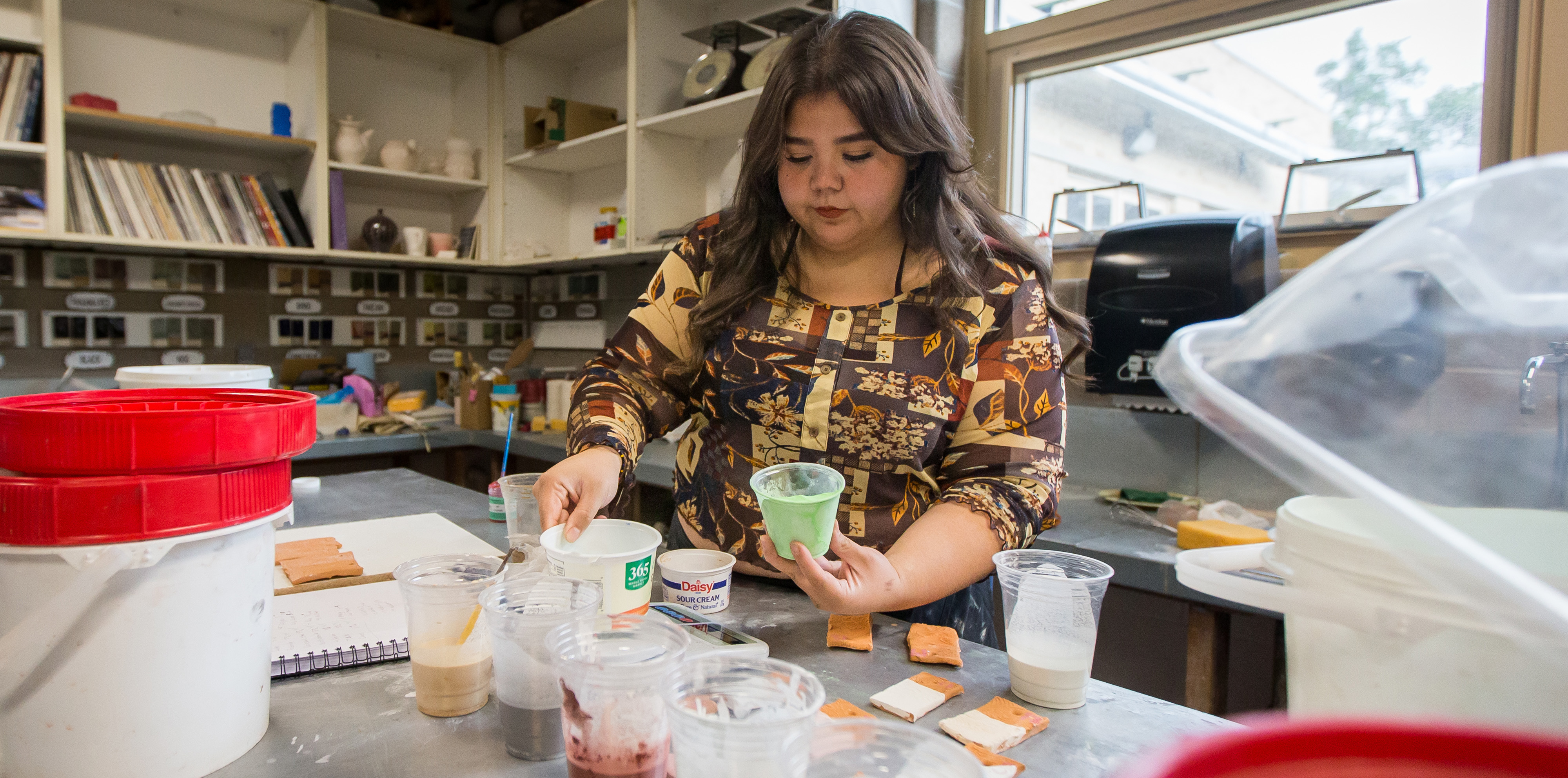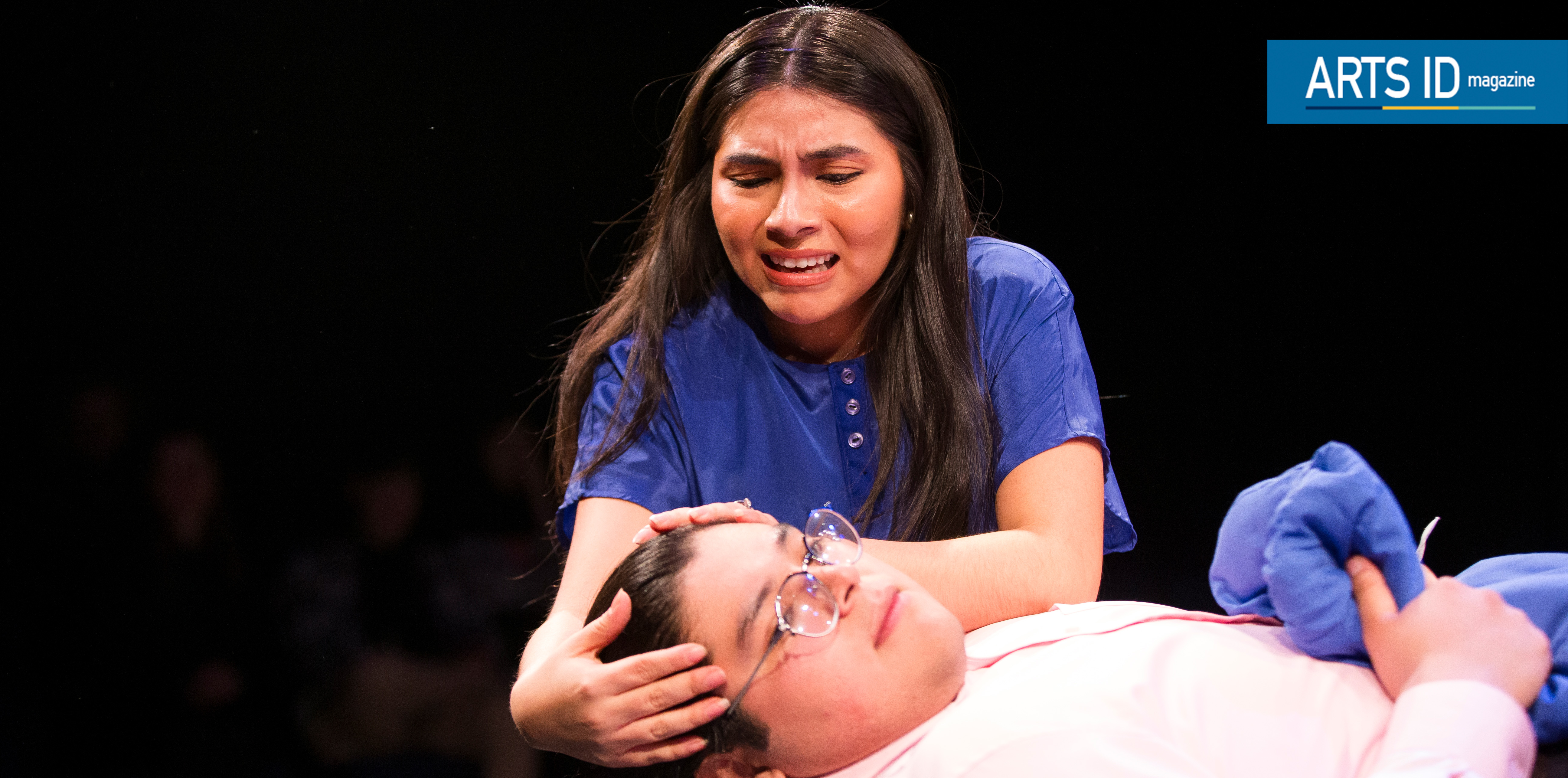
For Flor Leos, the opportunity to see the work of another artist was transformational.
Leos, a senior majoring in Ceramics and minoring in Mexican American Studies, says that when Chicano muralist Leo Tanguma came to UNC her junior year, it shaped her path and her view of her own art.
“It was the first time I saw myself and Mexican-American/Chicano life, experience and culture depicted and seen in a ‘fine’ art, a predominantly ‘white’ space. Before that, I hadn't seen art depicting the Mexican-American/Chicano people in any gallery,” she says.
Tanguma’s exhibit shared some of his artwork that, over the past 30 years, has chronicled and portrayed the struggles of oppressed peoples as they strive for dignity, justice, self-determination and human rights. Many UNC students and alumni are familiar with his mural “The Life and Times of Dr. Martin Candelaria” in the north stairway of Candelaria Hall, which depicts the building’s namesake and UNC’s first Hispanic professor Martin Candelaria. Tanguma also worked closely with students and presented a talk – “A Presentation and Conversation with Leo Tanguma: Chicano Artist” – that gave attendees insight and understanding about his artwork.
“There were many positive outcomes introduced into my life because of the Tanguma exhibit at UNC,” Leos says. "I was fortunate enough to work on a mural with Leo and other students that took a duration of one year. Leo and his wife Jeanne Tanguma are passionate, loving and supportive activists who nurtured other students and me over their year at UNC. While working on this mural, Leo and Jeanne shared first-hand testimonies about their activism during the 60s. Leo taught me about Chicanismo and painting techniques and gave invaluable advice. I’m eternally and forever thankful. All of this has influenced my art.”
Leos says that in middle school and high school she was more involved in performing art than visual art. It was something that gave her a creative outlet, but it was viewed more as a hobby and not a career.
“Especially being first generation and my parents being from Mexico, they were like ‘you need to like get a good job that pays you good money,’” she remembers.
She completed her associate degree in 2018 at Aims Community College and started working as a store manager, then at a bank. But she felt her work was mundane and uninspired. Then, during the pandemic, she had an opportunity to take a ceramics class.
“I remembered that growing up, I loved doing ceramics. I found out that I was actually kind of good at it,” she says. With the encouragement of her teacher and mentor, Sonya Paukune, Leos continued to work in the medium and found her way to UNC.
“I was born and raised in Greeley, so UNC was always the university that I was interested in. I always felt like I wouldn't be able to do it. It kind of felt out of reach for me,” Leos says
When she saw UNC had a Ceramics program, Leos applied and enrolled.
“In addition to the School of Art and Design community, I found a new community within the Mexican American Studies programand decided to add it as a minor. I learned about the impactful history Mexican Americans have had since the infancy of the United States.”
This past summer, she gained hands-on experience working as an intern for the Biennial of the Americas in Denver, an organization with a mission to “create connections, build community and inspire change across the Americas.”
“I was interning with Biennial, however, the broader scope of the internship was with DITA, which stands for ‘Diversity in the Arts.’ DITA is really focused on providing opportunities to marginalized groups or underprivileged groups to participate and make connections within the arts.
“As you know, a lot of internships are not paid,” she continues. “It's kind of classism because a lot of people don't have access to participate in internships if they're not getting money to support themselves. I would not have been able to participate in this had it not been a paid internship.”
Leos explains that DITA is an umbrella organization that works with 11 host sites, and she was paired with Biennial. As part of her internship, she helped with an installation for artist Gabriel Rico with Black Cube Nomadic Museum under Denver’s RedLine Contemporary Art Center.
Rico’s installation, La inclusión de mi raza (The inclusion of my race) included five totemic sculptures composed of a range of objects along with an augmented reality component.
“I was tasked with procuring and curating all of the ready-made objects from the community,” she says. “I was very lucky to have that experience,” she says, noting that it gave her an opportunity to talk with other interns about navigating a space that is traditionally white and corporate without losing their authentic selves.
“I realized that we need more representation in these spaces. I thought ‘how can I be here and present and help out so there's a lot of learning and growth?’ It was a very intense 10 weeks,” Leos says.
Returning to Greeley for her final year at UNC, she says that she has a clearer picture of herself as an artist not only from her time as an intern this past summer, but also because of Leo Tanguma’s influence on her last year.
“I've actually kind of switched from ‘functional art’ – like mugs – to more sculptural work. I realized that I want to make art that's more representational of me as Latina and as a woman. I've denied that part of my identity for so long, so this year I have a lot of sculpture ideas that are going to be reflective of Mexican Americans, as well as building sculptures that will show us being here in the United States before its conception. The violence that has been perpetuated against us tends to be forgotten, and I’ve learned a lot of my history in that as well.”
After graduating Leos hopes to pursue her master’s degree, but she says she also wants to give back to her community – much like Tanguma has impacted her with his work and words.
“I feel like I've been very privileged in learning more about art, and I want others to have more representation in art. I didn't have that representation growing up as much. My art is now more representational of me and my life experiences. Leo Tanguma's exhibit deeply and profoundly impacted how I viewed myself, art and the way I connected to UNC.”
– written by Debbie Moors
More Stories
-
From UNC to the National Stage: Opera Singer Kayla Nanto, ’15
Este artículo no está en español.
-
Bridging Art and Advocacy: That Day in Tucson
Este artículo no está en español.
-
Memorable Melodies, Music Faculty Shine with Grammy Nominations
Este artículo no está en español.
-
A Glimpse into the New Hybrid Master of Arts in Studio Art
Este artículo no está en español.





